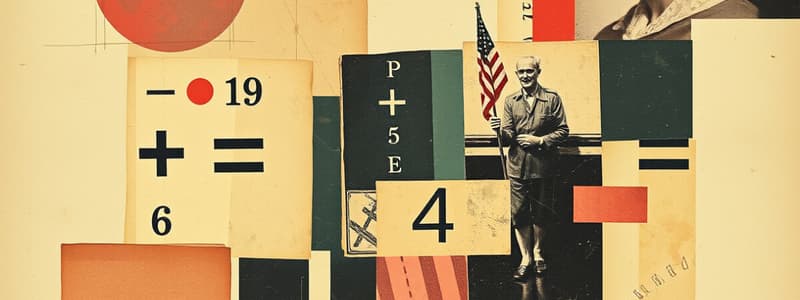Podcast
Questions and Answers
What is the symbol used for addition?
What is the symbol used for addition?
- *
- ÷
- + (correct)
- -
Which method involves starting with the larger number and counting up?
Which method involves starting with the larger number and counting up?
- Making Ten
- Using Fingers
- Grouping
- Counting On (correct)
What does the Commutative Property of Addition state?
What does the Commutative Property of Addition state?
- a + b = b + a (correct)
- a + b + c = 0
- (a + b) + c = a + (b + c)
- a + 0 = a
Which of the following is a technique for younger learners to perform addition?
Which of the following is a technique for younger learners to perform addition?
What is the result of applying the identity property on the number 7?
What is the result of applying the identity property on the number 7?
Which addition method involves breaking down numbers into smaller parts?
Which addition method involves breaking down numbers into smaller parts?
In which scenario is addition most commonly used?
In which scenario is addition most commonly used?
What is the technique where sums are made to total ten during addition?
What is the technique where sums are made to total ten during addition?
Which two properties of addition allow for changing the grouping or order of numbers?
Which two properties of addition allow for changing the grouping or order of numbers?
What is a benefit of using a calculator for addition?
What is a benefit of using a calculator for addition?
Flashcards are hidden until you start studying
Study Notes
Basic Addition Techniques
-
Understanding Addition
- Addition is the process of combining two or more numbers to achieve a total.
- The symbol for addition is "+".
-
Number Line
- A visual tool to represent addition.
- Start at the first number and move to the right by the value of the second number.
-
Counting On
- Start with the larger number and count up by the value of the smaller number.
- Example: To add 4 + 3, start at 4, then count 5, 6, 7.
-
Using Fingers
- A tactile method for younger learners.
- Represent numbers with fingers; combine by counting all extended fingers.
-
Grouping and Regrouping
- Breaking down numbers into smaller, manageable parts.
- Example: 13 + 9 can be regrouped as (10 + 3) + (10 - 1) = 20 + 2 = 22.
-
Doubles
- Recognizing pairs of numbers that add up to the same total.
- Example: 2 + 2, 3 + 3, etc. Helps with memory and speed.
-
Making Ten
- Techniques to create a sum of ten as an intermediate step.
- Example: 8 + 5 can be seen as 8 + 2 + 3 = 10 + 3.
-
Using a Calculator
- Technology assistance for performing addition quickly and accurately.
- Useful for larger numbers or complex calculations.
-
Properties of Addition
- Commutative Property: a + b = b + a (order doesn't matter).
- Associative Property: (a + b) + c = a + (b + c) (grouping doesn't matter).
- Identity Property: a + 0 = a (adding zero leaves the number unchanged).
-
Practice Exercises
- Regular practice helps reinforce addition skills.
- Use worksheets, flashcards, or online games for varied practice.
-
Real-Life Applications
- Addition is used in budgeting, shopping, cooking, and more.
- Understanding addition facilitates better decision-making in everyday tasks.
Understanding Addition
- Addition combines two or more numbers to form a total, denoted by the symbol "+".
Number Line
- A visual aid for addition, moving right from the first number by the second number's value.
Counting On
- Begin with the larger number and count upwards using the smaller number's value for addition, e.g., 4 + 3 starts at 4, counting to 7.
Using Fingers
- A hands-on approach ideal for younger learners, using fingers to represent numbers and combining them by counting all extended digits.
Grouping and Regrouping
- Involves breaking numbers into smaller parts for easier addition; for example, 13 + 9 can be regrouped to (10 + 3) + (10 - 1) to yield 22.
Doubles
- Identifying pairs of numbers that sum to the same total, such as 2 + 2 or 3 + 3, enhancing memory and speed in addition.
Making Ten
- Techniques to simplify addition by forming sums of ten; for instance, 8 + 5 can be reframed as 8 + 2 + 3 to make 10 + 3.
Using a Calculator
- Technology aids in rapid and accurate addition, especially useful for larger figures or complicated problems.
Properties of Addition
- Commutative Property: Order of numbers does not affect the sum (a + b = b + a).
- Associative Property: Grouping of numbers can change without altering the sum ((a + b) + c = a + (b + c)).
- Identity Property: Adding zero to a number doesn't change its value (a + 0 = a).
Practice Exercises
- Regular practice through worksheets, flashcards, and online games is essential for skill reinforcement in addition.
Real-Life Applications
- Addition plays a crucial role in daily activities, including budgeting, shopping, and cooking, improving decision-making skills in everyday scenarios.
Studying That Suits You
Use AI to generate personalized quizzes and flashcards to suit your learning preferences.




